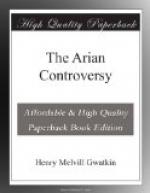[Sidenote: Gratian’s toleration.]
As Valens left no children, the Empire rested for the moment in the hands of his nephew, Gratian, a youth of not yet twenty. Gratian, however, was wise enough to see that it was no time to cultivate religious quarrels. He, therefore, began by proclaiming toleration to all but Anomoeans and Photinians. As toleration was still the theory of the Empire, and none but the Nicenes were practically molested, none but the Nicenes gained anything by the edict. But mere toleration was all they needed. The exiled bishops found little difficulty in resuming the government of their flocks, and even in sending missions to Arian strongholds. The Semiarians were divided. Numbers went over to the Nicenes, while others took up an independent or Macedonian position. The Homoean power in the provinces fell of itself before it was touched by persecution. It scarcely even struggled against its fate. At Jerusalem indeed party spirit ran as high as ever, but Alexandria was given up to Peter almost without resistance. We find one or two outrages like the murder of Eusebius of Samosata by an Arian woman in a country town, who threw down a tile on his head, but we hardly ever find a Homoean bishop heartily supported by his flock.
[Sidenote: Gregory of Nazianzus.]
Constantinople itself was now the chief stronghold of the Arians. They had held the churches since 340, and were steadily supported by the court. Thus the city populace was devoted to Arianism, and the Nicenes were a mere remnant, without either church or teacher. The time, however, was now come for a mission to the capital. Gregory of Nazianzus was the son of Bishop Gregory, born about the time of the Nicene council. His father was already presbyter of Nazianzus, and held the bishopric for nearly half a century. [Sidenote: 329-374.] Young Gregory was a student of many schools. From the Cappadocian Caesarea he went on to the Palestinian, and thence to Alexandria; but Athens was the goal of his student-life. Gregory and Basil and Prince




